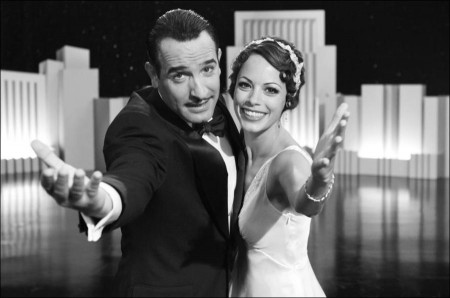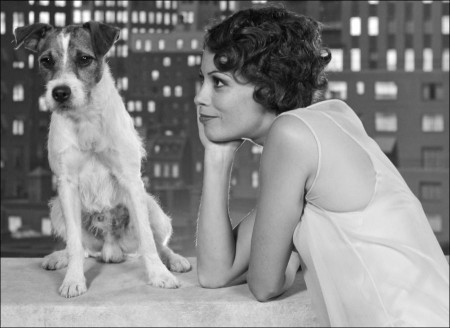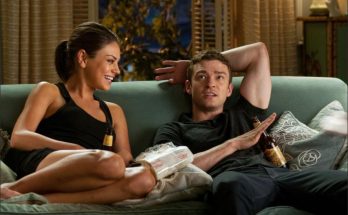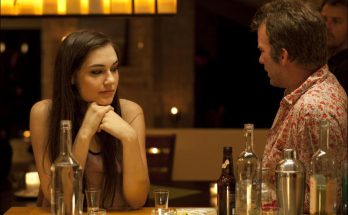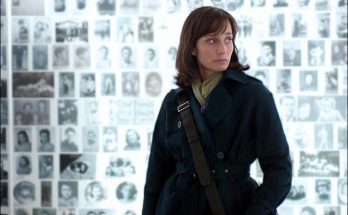Hollywood, 1927. George Valentin (Jean Dujardin) is one of Hollywood’s reigning silent screen idols, instantly recognizable with his slim moustache and signature white tie and tails. Starring in exotic tales of intrigue and derring-do, the actor has turned out hit after hit for Kinograph, the studio run by cigar-chomping mogul Al Zimmer (John Goodman). His success has brought him an elegant mansion and an equally elegant wife, Doris (Penelope Ann Miller).
Chauffeured to the studio each day by his devoted driver Clifton (James Cromwell), George is greeted by his own smiling image, emblazoned on the posters prominently placed throughout the Kinograph lot. As he happily mugs for a rapturous fans and reporters at his latest film premiere, George is a man indistinguishable from his persona — and a star secure in his future.
For young dancer Peppy Miller (Berenice Bejo), the future will be what she makes of it. Vivacious and good-humored, with an incandescent smile and a flapper’s ease of movement, Peppy first crosses George’s path at his film premiere and then as an extra on his latest film at Kinograph. As they film a brief dance sequence, the leading man and the newcomer fall into a natural rhythm, the machinery of moviemaking fading into the background. But the day must finally end, sending the matinee idol and the eager hopeful back to their respective places on the Hollywood ladder.
And Hollywood itself will soon fall under sway of a captivating new starlet: talking pictures. George wants no part of the new technology, scorning the talkie as a vulgar fad destined for the dustbin. By 1929, Kinograph is preparing to cease all silent film production and George faces a choice: embrace sound, like the rising young star Peppy Miller; or risk a slide into obscurity.
Beginnings
A celebration of Hollywood moviemaking at its most magical, THE ARTIST represents the fulfillment of a long-held dream for writer / director Michel Hazanavicius. “From the beginning of my career, I fantasized about making a silent film,” he says. “I call it a fantasy because whenever I mentioned it, I’d only get an amused reaction – no one took this seriously.”
But Hazanavicius was entirely serious. The legendary filmmakers he most admired had begun their careers in silent cinema: Alfred Hitchcock, Fritz Lang, John Ford, Ernst Lubitsch, F.W. Murnau, and, in his early years as a screenwriter, Billy Wilder. Mainly, though, he was drawn to the format for creative reasons. “As a director, a silent film makes you face your responsibilities,” he remarks. “Everything is in the image, in the organization of the signals you’re sending to the audience. And it6s an emotional cinema, it’s sensorial; the fact that there is no text brings you back to a basic way of telling a story that only works on the feelings you have created. I thought it would be a magnificent challenge and that if I could manage it, it would be very rewarding.”
In 2006, Hazanavicius scored a critical and commercial success with his second theatrical feature, the buoyant spy spoof OSS 117: CAIRO, NEST OF SPIES, starring Jean Dujardin and Berenice Bejo. A sequel, OSS 117: LOST IN RIO, followed in 2009, cementing Hazanavicius’s reputation as a maker of artful and crowd-pleasing entertainment. Set in the late 50s and early 60s, respectively, the films had given Hazanavicius a solid grounding in the logistics of period storytelling and cinematic tribute. With those back-to-back hits under his belt, the filmmaker decided to pursue his silent movie for his next project. His quest for a producer eventually led him to Thomas Langmann, whose credits include the award-winning MESRINE gangster films and whose father was the Oscar-winning filmmaker Claude Berri. Langmann immediately understood what Hazanavicius wanted to do and why. “Thomas is a producer like no other,” asserts Hazanavicius. “Not only did he take what I said seriously, I saw in his eyes that he believed in it. It was no longer a fantasy but a project. I could start working.”
As he began mulling story ideas, Hazanavicius remembered an anecdote he’d heard from a family friend, screenwriter and playwright named Jean-Claude Grumberg. One day, Grumberg pitched a producer an idea about a silent movie actor ruined by the arrival of talkies. “The producer had replied: “That’s wonderful, but the ’20s — that’s too expensive. Couldn’t it be set in the ’50s? Hazanavicius recalls. “That’s how this idea of a film set in the Hollywood of the late ’20s and early ’30s, in black and white, was formed. I don’t make films to reproduce reality. What I love is to create a show and for people to enjoy it and be aware that’s what it is, a show. In any case, you can’t remake films exactly the way they were made 90 years ago. Audiences have been exposed to so much; they are sharper, quicker and a lot smarter. It’s exciting to stimulate them.â€
He continues, “My starting point was a silent movie actor who doesn’t want to hear anything about the talkies. I circled around this character, and then I got the idea of this young starlet and crossed destinies. Everything fell into place, including the themes — pride, fame, vanity, love.” Having never written a silent film, Hazanavicius immersed himself in the genre to gain an understanding of what did and didn’t work. “At the very beginning I watched cinetime from all over: America, Germany, Russia, France, England. I observed that as soon as the story starts to grow unclear.“ too many new developments, too many characters — you lose interest,” he says. “Very soon I focused the last four or five years of the silent era, especially in America. I think those were the best cinetime, and also the ones that aged best. The way the stories are told in American silents isn’t so different that the way the stories are told today.”
Along with watching films, the director read cinema histories as well as memoirs and biographies of silent era directors, producers and stars. He looked at photographs and other archival materials and listened to music of the period. He drew inspiration from the work and lives of such stars as Douglas Fairbanks, Joan Crawford, Gloria Swanson, John Gilbert and Greta Garbo. “Research is very important,” he comments. “Not so much to be strictly realistic, that’s not what I’m after — but as a springboard for the imagination. The research fed the story, the context, the characters. The more research you have done, the more you can play with it all.”
Unfolding during a four year period, 1927-1931, THE ARTIST introduces its titular character, the action-adventure hero George Valentin, at the peak of his popularity. Fans flock to see George in films tailored to his dashing persona: exotic tales in which he triumphs over evil with wit, panache and the aid of his devoted sidekick, a Jack Russell terrier with impeccable timing. When sound arrives, George resists the upstart format (as did Chaplin, among others). He stakes his career on his belief that the talkies will remain a novelty, and sets out to prove that he can succeed on his own terms, as an artist of the silent cinema.
Though THE ARTIST is set over 80 years ago, George’s circumstances and the powerful emotions attached are as current as ever. Says Hazanavicius, “To me, it’s interesting to think of George’s story in terms of a human being in a transition period. The world is always moving, and you might be looking in another direction. One day, the world says to you, you’re part of the past.” It can happen in your own office, in your factory, in your relationship. It’s a feeling any person can understand.â€
But before he begins his descent from Hollywood heights, George meets the energetic young actress Peppy Miller. The famous actor and the effervescent unknown are irresistibly drawn to one another, but are kept apart by chance and circumstance, unable to give voice to their feelings. It’s a classic scenario of star-crossed romance, intense yet chaste. Its an old-fashioned vision of love, very pure, and it also holds with the form of silent cinetime, Hazanavicius. “Some of the masterpieces of silent cinema are simple love stories. They inspired me to take the film in a direction that was lighter, more optimistic and joyful.
By the time he finished writing, Hazanavicius felt confident that he had constructed a story that could sustain a silent format. Though he had never made a movie outside of France, Hazanavicius believed THE ARTIST — steeped in Hollywood cinema history, sensibility and technique — had to be shot in Los Angeles.
The Artist
Directed by: Michel Hazanavicius
Starring: Malcolm McDowell, John Goodman, Missi Pyle, Penelope Ann Miller, James Cromwell, Nina Siemaszko, Bitsie Tulloch
Screenplay by: Michel Hazanavicius
Production Design by: Laurence Bennett
Cinematography by: Guillaume Schiffman
Film Editing by: Anne-Sophie Bion, Michel Hazanavicius
Costume Design by: Mark Bridges
Set Decoration by: Robert Gould
Art Direction by: Gregory S. Hooper
Music by: Ludovic Bource
MPAA Rating: PG-13 for a disturbing image and a crude gesture.
Studio: The Weinstein Company
Release Date: November 23, 2011
Hits: 45
